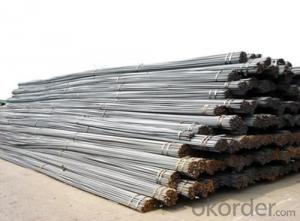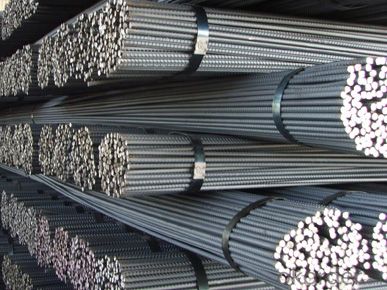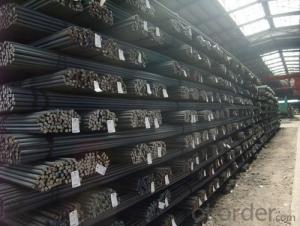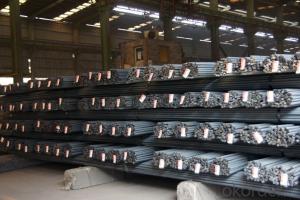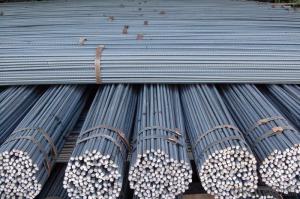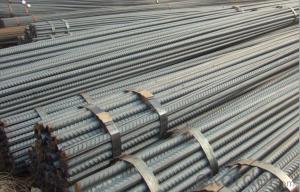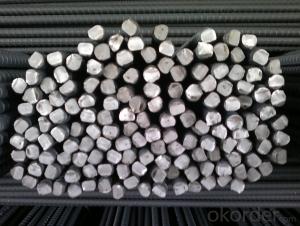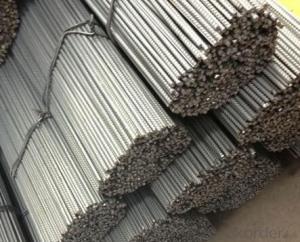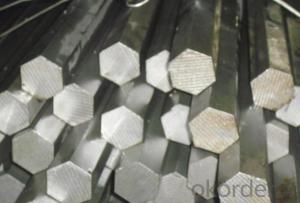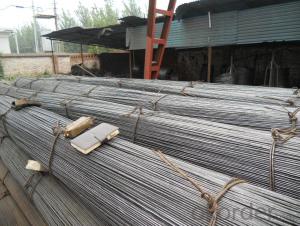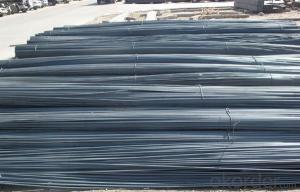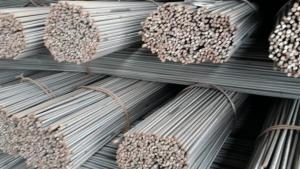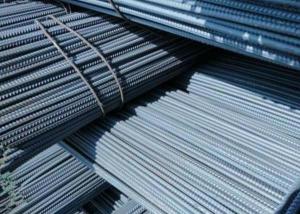Deformed Steel Bar Quality Guaranteed Thermo mechanically
- Loading Port:
- Tianjin
- Payment Terms:
- TT OR LC
- Min Order Qty:
- 28 m.t.
- Supply Capability:
- 20000 m.t./month
OKorder Service Pledge
OKorder Financial Service
You Might Also Like
Product Description
Deformed Reinforcing Steel Bar
Standard: AISI,ASTM,BS,DIN,BS,GB,JIS
Grade: HRB400/ HRB400E/ HRB500/ HRB500E/ Gr.40/ Gr.60/ B460B/ B500B
Diameter: 6mm-40mm
6mm,8mm rebar must be packaging in coil, ~2MT/coil
Length: 12m or 9m
Place of Origin: Hebei, China (Mainland)
Brand Name: Mammoth
Application: construction of houses, bridges, roads and other civil works,making Concrete
Packaging & Delivery
Packaging Details: | In bulk or Container according to the customer's require. |
Delivery Detail: | 15-30 days after L/C or prepayment. |
| THEORETICAL WEIGHT INDEX | ||
| SIZE(mm) | CUT AREA(CM2) | THEORETICAL WEIGHT(KG/M) |
| 8 | 0.503 | 0.395 |
| 9 | 0.636 | 0.5 |
| 10 | 0.79 | 0.62 |
| 12 | 1.13 | 0.89 |
| 14 | 1.54 | 1.21 |
| 16 | 2.01 | 1.58 |
| 18 | 2.55 | 2 |
| 20 | 3.14 | 2.47 |
| 22 | 3.8 | 2.98 |
| 25 | 4.91 | 3.85 |
| 28 | 6.16 | 4.83 |
| 32 | 8.04 | 6.31 |
♣ Mechanics Performance According to HRB335
Grade | Technical data of the original chemical composition(%) | |||||
C | Mn | Si | S | P | B | |
HRB335 | ≤0.25 | ≤1.60 | ≤0.80 | ≤0.045 | ≤0.045 | >0.0008 |
Physics capability | ||||||
Yield Strength(N/cm2) | Tensile Strength(N/cm2) | Elongation (%)
| ||||
≥335 | ≥490 | ≥16 | ||||
♣ Mechanics Performance According to HRB400
Grade | Technical data of the original chemical composition(%) | |||||
C | Mn | Si | S | P | V | |
HRB400 | ≤0.25 | ≤1.60 | ≤0.80 | ≤0.045 | ≤0.045 | 0.04-0.12 |
Physics capability | ||||||
Yield Strength(N/cm2) | Tensile Strength(N/cm2) | Elongation (%)
| ||||
≥400 | ≥570 | ≥14 | ||||
If you are interested in these kinds of products, please feel free to let me know, our best quotation will be sent for your information. Except steel bar, we also deal with steel pipe, deformed steel bar, angle steel, H and I beam, and channel. You are welcomed to visit our website www.tsruixiang.com.cn to know more about us.
And our products are mainly exported to Mild-east, South American, African, so please make assure of our quality and reputation. We sincerely hope we can cooperate in the near future.
Your any reply will be highly appreciated.
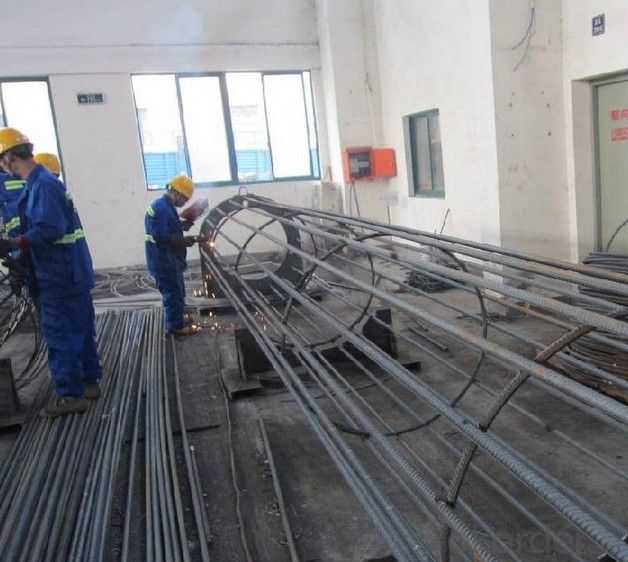

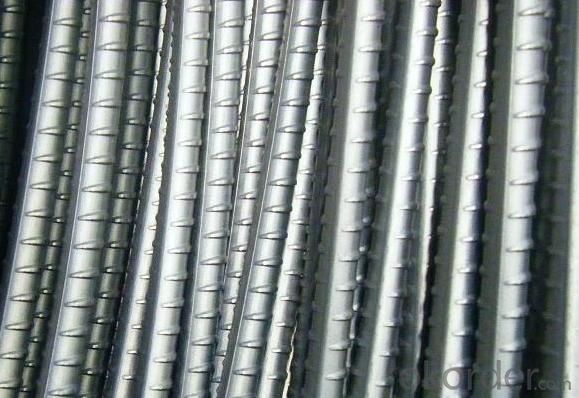
- Q: How are steel rebars stored and handled on construction sites?
- Steel rebars, also known as reinforcing bars, are an essential component in construction projects that require reinforced concrete structures. These rebars are typically stored and handled on construction sites in a systematic and organized manner to ensure their safety and efficient use. To begin with, steel rebars are often delivered to construction sites in bundles or bundles tied using wire or binding materials. Once the rebars are unloaded from the delivery truck, they are usually stored in designated areas known as rebar yards or cages. These areas are specifically designed to accommodate the length, size, and weight of the rebars, ensuring they are kept off the ground and protected from moisture, dirt, and any potential damage. In the rebar yard, rebars are commonly stacked horizontally and grouped according to their size, length, and grade. This arrangement facilitates easy identification and accessibility when needed for construction. Additionally, rebars are often separated by spacers or wooden blocks to prevent direct contact between them, reducing the risk of corrosion or tangling. When it comes to handling steel rebars, construction workers must prioritize safety and follow specific guidelines. Personal protective equipment, such as gloves and safety boots, should be worn to prevent injuries and ensure a secure grip on the rebars. In some cases, workers may use lifting equipment, such as cranes or forklifts, to move and transport rebars to different areas of the construction site. During transportation, rebars should be secured properly to prevent any shifting or falling, which could lead to accidents. Workers should also avoid dragging rebars on the ground, as this can cause damage to the bars or deform their shape, compromising their structural integrity. It is crucial to note that steel rebars should be inspected before use to ensure they meet the required specifications and are free from any defects. Rusty or damaged rebars should be discarded or repaired, depending on the severity of the issue. In summary, steel rebars are stored and handled on construction sites with utmost care and attention. Proper storage in designated rebar yards, correct grouping and separation, and adherence to safety guidelines during handling contribute to the successful and efficient use of steel rebars in construction projects.
- Q: What is the role of steel rebars in the construction of parking structures?
- Steel rebars play a crucial role in the construction of parking structures as they reinforce the concrete, enhancing its strength and durability. Rebars provide structural support, preventing cracking and ensuring the parking structure can withstand heavy loads and potential stresses over time. They help distribute the weight evenly, making the structure more stable and resistant to external forces such as earthquakes or impact.
- Q: Can steel rebars be used in the construction of residential buildings?
- Yes, steel rebars can be used in the construction of residential buildings. Steel rebars are commonly used as reinforcement in concrete structures, including residential buildings, to provide added strength and stability. They help to distribute loads and prevent cracking or failure in the concrete. Steel rebars are widely used in residential construction projects to enhance the overall structural integrity and durability of the building.
- Q: 12 of the threaded steel can replace 16 of the screw steel? But the same proportion. Thanks
- Now Tianjin Tiantai into 12 of the price is 3900 yuan a ton, 16 tons of steel a price is 3850 yuan. 12 of thread steel is 50 yuan more expensive than 16 thread steel.
- Q: Can steel rebars be used in water storage tanks?
- Yes, steel rebars can be used in water storage tanks. Steel rebars provide structural strength and reinforcement to the tanks, making them suitable for holding and retaining water.
- Q: How do steel rebars affect the overall construction cost of residential buildings?
- The overall construction cost of residential buildings can be significantly influenced by steel rebars. To begin with, steel rebars play a vital role in reinforced concrete structures by adding strength and durability. However, the cost of steel rebars can vary depending on factors such as size, grade, and the quantity required for the project. The inclusion of steel rebars in residential buildings can lead to increased construction costs due to expenses related to their purchase and installation. The cost of steel itself is subject to market fluctuations and can change over time. Furthermore, the complexity of the design and the amount of reinforcement needed can also impact the overall cost. Moreover, the installation of steel rebars involves skilled labor, which further contributes to construction expenses. The process of cutting, bending, and placing rebars requires expertise and precision, which adds to the cost of labor. Additionally, the time required for proper installation can affect the construction schedule, potentially resulting in additional expenses if there are delays. However, it is important to note that although steel rebars may initially increase the upfront construction cost of residential buildings, their long-term benefits outweigh the initial expenses. Reinforced concrete structures with steel rebars offer improved resistance against structural failures, such as cracking or collapsing, which can save significant costs in terms of future repairs and maintenance. In conclusion, steel rebars are essential components in residential construction as they enhance the strength and durability of reinforced concrete structures. While their use may increase the initial construction cost, the long-term advantages in terms of structural integrity and reduced maintenance expenses justify their inclusion in residential building projects.
- Q: Can steel rebars be used in pedestrian bridge construction?
- Yes, steel rebars can be used in pedestrian bridge construction. Steel rebars are commonly used as reinforcement in concrete structures, including bridges. They enhance the structural integrity and strength of the bridge, ensuring its ability to withstand various loads and forces. Steel rebars provide the necessary reinforcement to resist tension, bending, and shear forces, making them an ideal choice for pedestrian bridge construction. Additionally, steel rebars have excellent durability, corrosion resistance, and are readily available, making them a cost-effective and reliable option for bridge construction.
- Q: Can steel rebars be used in structures with high levels of carbonation or acid attack?
- Steel rebars should not be used in structures with high levels of carbonation or acid attack. Carbonation occurs when carbon dioxide from the atmosphere reacts with the alkaline compounds in concrete, resulting in the reduction of the concrete's pH level. This process can lead to the corrosion of steel rebars, as the lower pH levels create an acidic environment that promotes rusting. Similarly, acid attack occurs when structures come into contact with acidic substances, such as industrial chemicals or acid rain. Acidic environments accelerate the corrosion process by further reducing the pH levels of the concrete, increasing the risk of steel rebar deterioration. To prevent these issues, alternative materials like stainless steel, epoxy-coated rebars, or fiber-reinforced polymer rebars can be used in structures exposed to high levels of carbonation or acid attack. These materials have enhanced corrosion resistance properties, providing better durability in challenging environments. It is crucial to consider the specific conditions in which the structure will be exposed and consult with structural engineers to select the most suitable materials for long-term performance and safety.
- Q: How are steel rebars cut and bent on-site?
- Specialized tools and equipment are utilized on-site to cut and bend steel rebars. The process typically consists of the following steps: 1. Measurement: The rebars are measured according to the specified length and dimensions in the construction plans. This step is crucial to ensure precise and accurate cutting and bending. 2. Cutting: Various tools, such as manual rebar cutters, hydraulic shears, or portable electric cutters, are employed to cut the rebars. These tools are designed to make clean and precise cuts without damaging the rebars. The rebars are securely positioned, and the cutting tool is applied to the marked area to achieve the desired length. 3. Bending: Once the rebars are cut to the required length, they are bent using rebar benders. These machines possess different attachments and rollers to shape the rebars into the desired angle and radius. The rebars are cautiously positioned and secured in the bender, and the machine exerts force to bend them according to the specified shape. 4. Quality control: Following the cutting and bending stages, quality control checks are conducted to ensure that the rebars meet the required specifications. This may include visual inspections, measurements, and testing to verify the accuracy of dimensions and the quality of cuts and bends. It is important to note that skilled workers, such as ironworkers or steel fixers, typically assume responsibility for on-site rebar cutting and bending. They possess the expertise to interpret construction plans, utilize the appropriate tools, and guarantee the accurate cutting and bending of rebars to meet the project's requirements.
- Q: Can steel rebars be used in tunneling and mining operations?
- Steel rebars have a wide range of applications, including tunneling and mining operations. These steel bars, typically used for reinforcing concrete structures, can also be utilized in underground construction projects like tunnels and mines. By incorporating rebars into these environments, additional strength and stability are provided to the structures, ensuring durability and safety. In tunneling projects, it is common to embed rebars in shotcrete or concrete linings to enhance the structural integrity of the tunnel walls and prevent collapse. Similarly, in mining operations, rebars are used to reinforce the roofs, walls, and support structures within the mine, protecting against potential hazards such as rockfalls and cave-ins. The use of steel rebars is essential in maintaining the integrity and stability of these underground structures during tunneling and mining operations.
Send your message to us
Deformed Steel Bar Quality Guaranteed Thermo mechanically
- Loading Port:
- Tianjin
- Payment Terms:
- TT OR LC
- Min Order Qty:
- 28 m.t.
- Supply Capability:
- 20000 m.t./month
OKorder Service Pledge
OKorder Financial Service
Similar products
Hot products
Hot Searches
Related keywords
